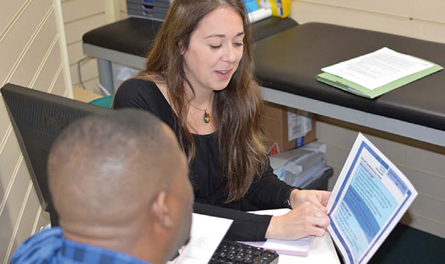Clinical

Talking about innovative services
In Clinical
Bookmark
Record learning outcomes
Patients were significantly more open about medical conditions over Skype than when they visited the pharmacy
Pharmacy Voice’s Talking Point showcases novel pharmacy services. ICP summarises three particularly interesting developments
MURs via Skype
Young pharmacist and DPharm student at Bradford University Wisam Tatari has conducted research into delivering MURs and COPD clinics through Skype. Mr Tatari – a director of internet pharmacy Drugs4Delivery – is passionate about helping difficult-to-reach patients and his research has already attracted the interest of NHS England and others.
Skype, as a free and widely-used application, is readily available to patients able to access a broadband internet connection. Patients were asked if they would be willing to conduct their MUR over Skype. The pharmacist then conducted the conversation in the consultation room, ensuring the patient’s privacy.
Of the patients approached, 85 per cent were happy to use the service through Skype. Some needed a little software training, which did not appear to hinder the process. Given that Skype consultations are already widely used across the NHS, the research attributed minimum privacy risk to the service.
Mr Tatari observed that patients were significantly more open about medical conditions over Skype than when they visited the pharmacy. He attributed this to the sense of security patients feel discussing personal issues in their own home.
Visual contact made it significantly easier to build rapport with patients than over the phone, found Mr Tatari. Plus, he could demonstrate the correct way to use medication and inhalers on-screen.
Early detection of lung cancer
Doncaster has a higher incidence of lung cancer than similar sized areas, largely due to late stage diagnosis, so early detection is now a key priority for its CCG. Last September it set up a pilot scheme where community pharmacies refer patients directly for a chest x-ray. The 12-month scheme involves nine community pharmacies covering around 70,000 local people.
This project recognises that people who present late with lung cancer may not visit their GP until very unwell, but may pass by their local pharmacy in the meantime. In addition, patients who end up being diagnosed via emergency presentation are often those who rarely visit their GP or are not even registered with a GP.

Laura Sharp, of Sharp D&R Chemists, one of the
pharmacies involved in the Doncaster pilot
Pharmacists received training on the referral protocol and counter assistants were trained on symptom recognition and counselling skills.
The project aims to improve the diagnosis of lung cancer and other lung conditions by:
- Detecting symptomatic lung cancer earlier
- Reducing the number of people presenting at A&E with advanced lung cancer
- Diagnosing previously undetected lung abnormalities such as chronic obstructive pulmonary disease (COPD).
A similar, 12-week pilot had already shown that pharmacy could have a role in this area. The earlier scheme made 60 referrals, 55 of which were considered appropriate. It did not find any cases of lung cancer, but nearly a third of those who had a chest x-ray were found to have previously undiagnosed moderate to severe COPD.
Health goals and care plans
The Community Pharmacy Future (CPF) project, running in the North Kirklees and Wakefield areas of West Yorkshire, puts patient health goals at the heart of its ambitions. Each participating patient has been supported to develop an individual care plan setting out the health goals they want to achieve and how their pharmacy teams can help them reach their targets.
Each patient’s care plan is placed in a folder along with appropriate supporting materials and leaflets. As patients return to collect their regular medication, the pharmacy team take the opportunity to discuss their progress with the health goals and to offer support, signposting and guidance. New health goals can be set if good progress is being made.
Pharmacists are using the Patient Activation Measure (PAM) to consider how they can support their patients. PAM looks at how involved patients are with their own health and how confident they are about making lifestyle changes.
The service is being delivered by around 50 pharmacies, both independents and multiples. Of over 800 patients who expressed an interest in the service, 705 were enrolled and went through a baseline assessment and an initial consultation to develop their personalised patient care plans. These patients are now going through a six-month review.
Pharmacy Voice, in collaboration with Pfizer Healthy Partnerships, released the second edition of its ‘Talking Point’ best practice publications on July 5. Talking Point is a series of publications targeted at commissioners and pharmacy teams, showcasing some of the programmes, initiatives and individuals working to improve patient outcomes and demonstrating the value of the pharmacy sector.
The third edition of Talking Point, with a focus on community pharmacy integration with other health and social care providers, will be published in November.
Talking Point can be downloaded from the Pharmacy Voice website.
